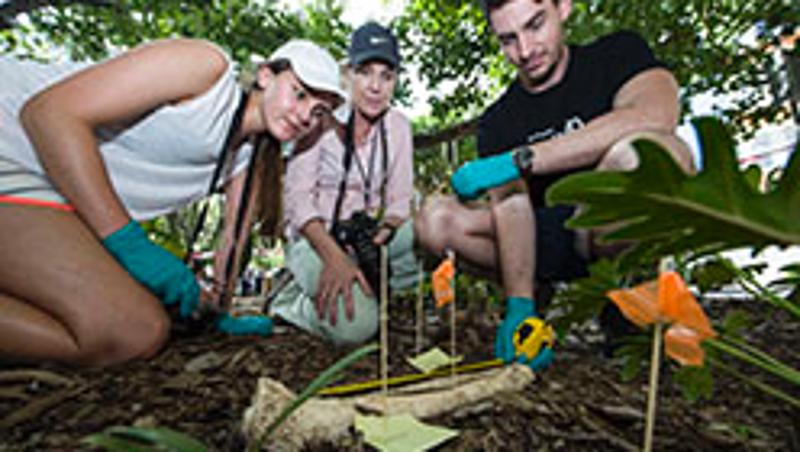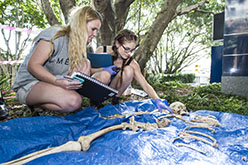
It’s CSI, Silent Witness and Bones rolled into one university course – Forensic Anatomy is one of the most exciting learning experiences of their degree, say QUT Bachelor of Biomedical Science students who took the new course last semester.
QUT forensic anthropologist Donna MacGregor designed the course to give students a real-world taste of what it’s like to gather evidence at crime scenes, prepare a report and be an expert witness in court.
“As far as I know, this is the only course in Australia that takes the students from the muddy boots of fieldwork and remains retrieval right through to the courtroom where they must justify their findings so that they experience the whole forensic process,” Ms MacGregor said.
 Ms MacGregor consults to the police as a forensic anthropologist and called upon her colleagues in both organisations to develop the course and give guest lectures.
Ms MacGregor consults to the police as a forensic anthropologist and called upon her colleagues in both organisations to develop the course and give guest lectures.
“It is important that the scenes we set up are as lifelike as possible because this course is designed to build problem-solving and critical thinking,” Ms MacGregor said.
“In the first scenario, the students entered a mock crime scene complete with spattered blood. They had to find and collect forensic evidence, and prepare a case file as they documented their findings.
“They identified and collected hair samples, trace DNA and fingerprints as well as identified blood spatter patterns.
“The students then completed a report which was a synopsis of their casefile plus their opinions for submission to court to be included in a brief of evidence.”
Ms MacGregor said that while students found the next phase of oral delivery of their findings daunting they rose to the challenge and found it a valuable experience.
“Finally, they presented their report in the form of expert evidence and then underwent cross examination,” she said.
“We held this in the moot law courtroom in the QUT Gardens Point Law Library. Two colleagues, a barrister and a forensic police officer, assisted in the moot courts.
“The second scenario was a missing person where the students, working in teams of six, investigated bones scattered in a field.
“The challenge was to process the skeletal recovery scene by marking out a grid and flagging where each bone was found.
“They then had to recover the skeleton and take it back to the lab to determine its biological profile including ancestry, sex, age and stature, any trauma, pathology or anomaly that might help identify the person.”
Ms Macgregor said the practical sessions were supported by lectures from industry professionals including a forensic pathologist, police scientific and disaster victim identification (DVI) officers, and barristers.
She said the 38 students who took the course, who had various plans for their future careers from joining the police service, studying medicine or becoming researchers, had overwhelmingly endorsed the course:
Kristy Winter, a double degree Forensic Science and IT student, changed her degree when she heard about the new Forensic Anatomy course last year.
“I have wanted to be forensic anthropologist since I was 10, so I changed to a Bachelor of Biomedical Science so I could take the course,” she said.
“It was the best unit I have ever taken and the guest lecturers were all really great. I intend doing an honours research project with Ms MacGregor and I see three career options: working for the UN for the benefit of humanity, being a museum curator or staying in academia.”
Ms MacGregor said the course had been modified into a VC STEM project for the upcoming mid-semester break to provide high school students a taste of the real-world courses QUT offers.
Media contact: Niki Widdowson, 07 3138 2999 or Rose Trapnell, QUT media team leader, 07 3138 2361 or 0407 585 901, rose.trapnell@qut.edu.au or media@qut.edu.au.




